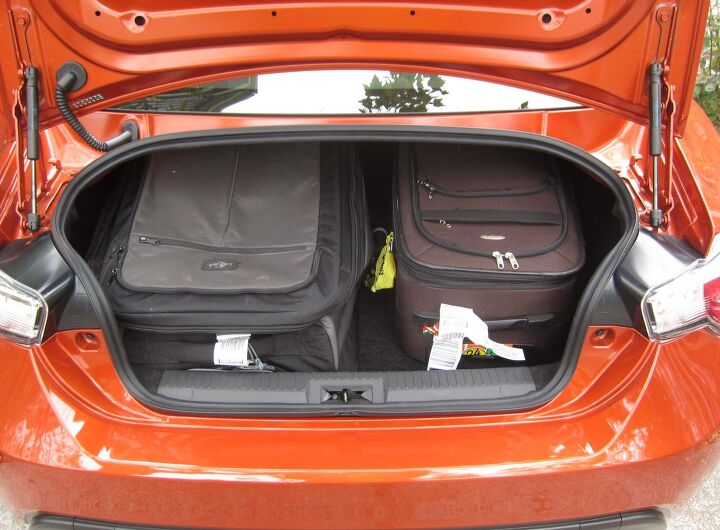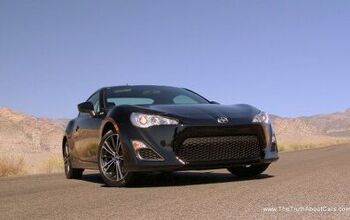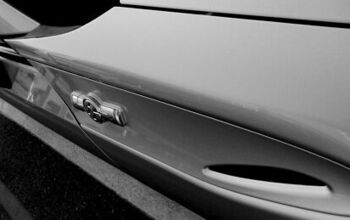Review: 2013 Scion FR-S

We’ve already looked at the FR-S, but I came of car-driving age just minutes before the heyday of the Toyota AE86 and, by God, I’m going to write about any car that claims to be an homage to the car that stands as the ’55 Chevy of Japan. So, I got on the horn with Toyota PR: “Hey, Moe, it’s Murilee Martin. Yeah, that Murilee Martin. Listen, I’m heading out to the East Bay next weekend and I need something that won’t embarrass me when I need to out-donut the Glasshouse Caprices at the sideshows in Oakland, know what I’m saying? Sure, the FR-S sounds good!”
Actually, given that automotive PR guys probably assume that car writers treat their cars like gorillas all jacked up on adrenachrome-and- Douglas Fir liqueur cocktails, I probably could have said exactly those words and it wouldn’t have raised any eyebrows. In reality, though, I was coming out to California to visit family and spend a day tailgating before an Oakland Athletics game. I picked up the car at the Oakland Airport and was parked next to the Faster Farms 1966 Plymouth Belvedere race car and eating barbecued meat products about five minutes later.
Since the airport and the ballpark are about two miles from each other, I didn’t get much chance to do any real driving right away. However, I did do a real-world trunk-capacity test right away, and learned that you can fit two good-sized suitcases with no hassle. The back seat provides additional cargo space; you won’t be putting any passengers back there, but we’ll return to that subject a bit later.
So, I had about five hours of tailgating time to examine the details of the car and discuss them with my super-geeked-out car-expert friends. I’ve driven, ridden in, and wrenched on quite a few AE86s, and this car looks nothing whatsoever like the Hachi-roku. This is good, because there’s something depressing about car companies exhuming the long-dead corpses of their past and using them to hawk modern machinery.
Once you start looking at the details, you’ll find many more cues that point to Subaru rather than Toyota. The boxer-4 engine, of course, is straight-up Subaru.
The build tag shows that the car was built by Fuji Heavy Industries, the interior materials feel much more Subaru-ish than Toyota-esque, and the inner fenders are stamped SUBARU.
On that subject, everybody, including me, refers to this car as a Toyota, which is as good an indication as any that the Scion brand hasn’t sunk deep roots in the car-buying public’s consciousness.
Here’s a little detail that says a lot about the philosophical differences between German, Japanese, and American automotive engineers. My friend Shawn, of Junkyard Build Quality Challenge fame, pointed out this anti-honk box attached to the air cleaner housing. Anti-honk boxes (or whatever the technical term is— anti-resonance chamber?) change the volume of the engine’s air-intake tract so as to avoid unpleasant audio resonance at certain engine speeds and loads. The Detroit carmakers don’t really care if your sub-$30k car’s engine makes a noise like a seasick rhinoceros sometimes— just shoot some more insulation on the firewall, problem solved! German engineers can’t tolerate the idea of engine honk, so they redesign the entire intake system if necessary. Toyota and Subaru, however, looked at their budget for this car, calculated the cost of modifying the parts-bin air cleaner (which was probably taken off the Impreza or Corolla or whatever high-production-level part came closest to fitting), and opted for the addition of a simple anti-honk box. I’d planned on stuffing a sock into the anti-honk box’s inlet and seeing how bad the honk really was, but ran out of time.
I always like to nose around under the hood of a new car, to get a sense of what corners were cut. The electrical connectors looked to be of pretty high quality— both Subaru and Toyota have always been good about not pinching yen too ruthlessly in that department— but I noticed a few things that you wouldn’t expect to see on even the cheapest Toyota. For example, these plastic headlight-assembly brackets. A few years of underhood heat will make them fragile, and then someone leaning over the hood will put a knee into the headlight and snap the brackets. This is the sort of thing you expect from Chrysler, circa 1991, not Toyota or Subaru.
Likewise, who uses these Manny, Moe, and Jack-grade, 1952-technology hose clamps nowadays?
My first real complaint about the FR-S came up when I decided to crank up some Ant Banks on the sound system, for the enjoyment of my tailgating companions. This is the 21st century, you can buy full-featured MP3 players direct from China for, like, $6.59, and there’s really no excuse for a factory stereo with alleged iPod interface to be such a pain in the ass to navigate.
Then there’s the quality of the sound system itself; the demographic most likely to buy this car is going to insist on some serious boom, and the standard 300-watt Panasonic system delivers less bass than the junkyard setup I stuffed into my ’92 Civic for a total investment of 25 bucks. Definitely not Tigra and Bunny– approved. I had to stick with no-thud-required stuff (e.g., the Dead Kennedys) for the soundtrack of my East Bay visit.
The day after the A’s tailgate party, I decided to take the FR-S on a tour of all my favorite East Bay wrecking yards (you can see the results in the most recent Junkyard Find posts). Junkyards are almost always in areas with terribly potholed roads, and I learned right away that you don’t want to set the car in the stiff “VSC Sport” mode on such roads. I needed a junkyard taco-truck meal just to settle my stomach after getting a beating that felt like sitting in a trash can being dragged over railroad ties.
Even normal highway driving is pretty miserable when in Sport mode, and the car hangs onto the pavement far beyond my admittedly meager driving abilities when taking freeway interchanges at fun speeds anyway, even with all the stability- and traction-control nannies in full effect. The ride is plenty firm when in non-sport mode, but it’s like a comfy Barcalounger next to the bouncy, noisy original AE86. The FR-S would make a completely non-punitive commuter, unless your idea of commuting comfort was derived from the 1974 Cadillac Sedan DeVille.
Another minor quibble that would be a bigger deal if I were driving this car in the Ivy Mike-level bright sun of Denver: the windshield reflections off the reflective dashboard surface. I thought the car companies solved this problem 15 years ago.
Right, so what’s this thing like to drive? It took me a while to figure it out, but after a few hours of horsing around in empty industrial areas of East Oakland I realized that the FR-S isn’t an homage to the original AE86. It’s an homage to the heavily modified drifter/tuner AE86s of the last decade.
The original Corolla GT-S (or Sprinter Trueno, or whatever you want to call it) was a spindly, 2,200-pound econobox of simple construction that was fitted with a pretty-good-for-the-mid-80s 112-horsepower L4 engine. Adding a bunch of power— which, of course, just about every AE86 owner has done by now— turns the car into a real handful, a parts-busting beast that’s eager to wrap itself around the nearest utility pole.
So, the 2,700-pound, 200-horsepower FR-S is to the drifter AE86 as the SRT8 Challenger is to the tunnel-rammed-440-equipped street-racer Challenger of the early 1970s. Just as the new Challenger turns once-difficult burnouts, convenience-store-parking-lot donuts, and 12-second quarter-mile passes into accomplishments that any idiot can pull off with almost no practice, so does the FR-S put all the dorifto moves of Initial D into the grasp of just about any schlub. You want to wow the kids in the mall parking lot with a perfect 180-degree E-brake turn on your first attempt? The FR-S will oblige. In fact, this car makes the previous E-Brake Turn Champion of the World (a rented Chevy Cobalt in a badly paved racetrack paddock) seem uncontrollable by comparison.
The same goes for moves that require you to blow away the rear tires and slide around like an idiot. Turn off the traction control, cock the wheel a bit, get on the gas, and you’ll be drifting around like some dude who killed a dozen Nissan 240SXs as the price for learning his skills.
My prediction: When these cars depreciate enough to put them within reach of the 16-to-22-year-old crowd, say ten years from now, look out! We’re going to see FR-Ss upside-down, on fire, and/or T-boned-into signposts wherever teenagers gather.
For the grownups who don’t care much about Japanese street-racing fads, the FR-S will make a pretty good weekday commuter/weekend autocross car. I didn’t have as much fun driving it as I did with the Mazda RX-8 (the Mazda feels lighter and less like a drag racer), but the FR-S manages to get nearly double the fuel-economy of the Wankel-powered machine, while being several orders of magnitude better-looking. If you want the opinion of Jack “The Ohio Player” Baruth, who is capable of going quickly around a race track in most un-car-journo-ish fashion, on the FR-S’s racetrack prowess, go here.
Something felt strangely familiar about the FR-S as I drove it from junkyard to junkyard, and then it hit me: the stiff, super-short-throw shifter and gargly boxer engine sound might as well have been swapped directly from my wife’s ’04 Subaru Outback. Once again, the FR-S feels more like a Fuji Heavy Industries product than a Toyota product.
I approve of the semi-old-timey-looking instrument cluster, though the weirdly centered speedometer is more or less useless (there’s a digital speed display inside the tach).
The racy-style front seats are great for hurling the car through tight turns and they’re quite comfortable in spite of the goofy-looking thick red stitching; more to the point, they look like the kind of aftermarket component that generations of Hachi-roku owners have bolted into their cars.
The sill plates have this puzzling polka-dot motif, which is carried over to the pedals.
The back seat, well, isn’t. My 12-year-old niece, who’s about 4′ 8″ tall and skinny, couldn’t find a way to sit comfortably in the back of the FR-S. The rear seat area should work well for grocery bags, though, and you can use the seat belts to keep the bags from sliding around as you execute a psychotic power-slide all the way across the Safeway parking lot.
The HVAC controls are uncomplicated, which is good, but the control mechanisms feel crappier than what I’m used to on Toyota cars.
While on my tour of the industrial East Bay, I happened upon this parked mid-80s Cressida. Note the size similarity between the roomy luxury car and the snug sporty car. Also note that the Cressida is sittin’ on some bullshit compared to the Scion.
The FR-S is still small when parked next to a ’66 Belvedere. My verdict on the FR-S: I could drive this thing every day and be very happy with it, but I’d expect Subaru reliability instead of the (historically superior) Toyota version. At $24,997 as tested, the FR-S has a pretty good bang-for-buck ratio… but I’d also take a long look at the similarly priced Miata before I bought one.

Murilee Martin is the pen name of Phil Greden, a writer who has lived in Minnesota, California, Georgia and (now) Colorado. He has toiled at copywriting, technical writing, junkmail writing, fiction writing and now automotive writing. He has owned many terrible vehicles and some good ones. He spends a great deal of time in self-service junkyards. These days, he writes for publications including Autoweek, Autoblog, Hagerty, The Truth About Cars and Capital One.
More by Murilee Martin
Latest Car Reviews
Read moreLatest Product Reviews
Read moreRecent Comments
- Theflyersfan After looking it over, Honda, I want royalties for this one: The Honda Yawn.
- V8fairy Not scared, but I would be reluctant to put my trust in it. The technology is just not quite there yet
- V8fairy Headlights that switch on/off with the ignition - similar to the requirement that Sweden has- lights must run any time the car is on.Definitely knobs and buttons, touchscreens should only be for navigation and phone mirroring and configuration of non essential items like stereo balance/ fade etc>Bagpipes for following too close.A following distance warning system - I'd be happy to see made mandatory. And bagpipes would be a good choice for this, so hard to put up with!ABS probably should be a mandatory requirementI personally would like to have blind spot monitoring, although should absolutely NOT be mandatory. Is there a blind spot monitoring kit that could be rerofitted to a 1980 Cadillac?
- IBx1 A manual transmission
- Bd2 All these inane posts (often referencing Hyundai, Kia) the past week are by "Anal" who has been using my handle, so just ignore them...


















































































Comments
Join the conversation
Here's the thing about the back seat...It sucks but it is there. I have a Miata for my commuter. When my wife calls and says she has gotten held up and can't pick up the kids, I drive home, get in my Land Cruiser, and go get the kids. Now take the Cruiser out of the equation. Maybe the kids only ride in my car once a month, but with a family of 4 it becomes pretty inconvienent to own the Miata. The kids can suck it up for a few minutes in the back of the FR-S...With the Miata one gets to suck it up walking. Someone with a family would be waaaay more likely to consider the FRS than the Miata. It's obviously not the primary family hauler, but it can haul the family in a pinch. The Miata can't.
Toyota has been using plastic headlight brackets for decades...look at this video on the 1999 Camry...plastic brackets: http://www.youtube.com/watch?v=v8mc5_HmjJI&feature=share&list=UUsD7YXhIUr-bn4tSPcVqkHw I really like that you poke your head under the hood though, nobody does that anymore...good review...definitely need to drive it!